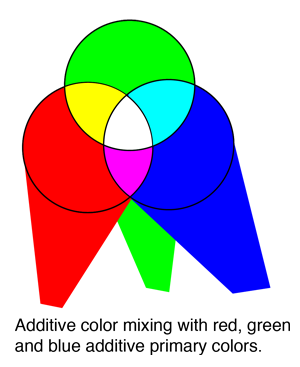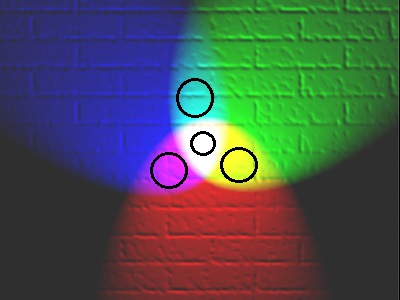Seemed to me it isn’t a real wavelength, that explains it, I had never heard of the term extra-spectral before. In my mind it’s a faux color then, just my way of expressing extra-spectral. I had a teacher in high school tell me yellow isn’t a real color because we can’t really see yellow, I suppose, he meant we don’t have color cones (in general, some rare people with four cones do) for yellow. However, yellow is a real wavelength, then I started thinking about magenta, that color just didn’t seem to be a real wavelength to me, a eye-brain thing. An illusion.
Edit: Found this (interestingly, although it makes sense to me now, I had never thought of white being a faux color until now):
Extra-spectral colors
Among some of the colors that are not spectral colors are: Spectral color - Wikiwand
- Grayscale (achromatic) colors, such as white, gray, and black.
- Any color obtained by mixing a gray-scale color and another color (either spectral or not), such as pink (a mixture of a reddish color and white), or brown (a mixture of orange and black or gray).
- Violet-red colors, which in color theory include line of purples colors (such as, approximately, magenta and rose), and other variations of purple and red.
- Impossible colors, which cannot be seen under normal viewing of light, such as over-saturated colors or colors that are seemingly brighter than white.
- Metallic colors which reflect light by effect.
The mention of “impossible colors”, above, caught my attention, found this:
“Impossible colors are colors that do not appear in ordinary visual functioning. Different color theories suggest different hypothetical colors that humans are incapable of seeing for one reason or another, and fictional colors are routinely created in popular culture. While some such colors have no basis in reality, phenomena such as cone cell fatigue enable colors to be perceived in certain circumstances that would not be otherwise.”
Claimed evidence for the ability to see colors not in the color space

Some people may be able to see the color “yellow–blue” in this image by letting their eyes cross so that both + symbols are on top of each other
note: calibrated to 58mm separation, please use zoom if needed to adjust.

Some people may be able to see the color “red–green” in this image by letting their eyes cross so that both + symbols are on top of each other
note: calibrated to 58mm separation, please use zoom if needed to adjust.

Most people see very bright colored concentric circles in this pattern, if it is printed and rotated at around 150–300 rpm. Alternate version with inverse contrast yields opposite effect.
According to the opponent-process theory, under normal circumstances, there is no hue that could be described as a mixture of opponent hues; that is, as a hue looking “redgreen” or “yellowblue”.
In 1983, Hewitt D. Crane and Thomas P. Piantanida performed tests using an eye-tracker device that had a field of a vertical red stripe adjacent to a vertical green stripe, or several narrow alternating red and green stripes (or in some cases, yellow and blue instead). The device could track involuntary movements of one eye (there was a patch over the other eye) and adjust mirrors so the image would follow the eye and the boundaries of the stripes were always on the same places on the eye’s retina; the field outside the stripes was blanked with occluders. Under such conditions, the edges between the stripes seemed to disappear (perhaps due to edge-detecting neurons becoming fatigued) and the colors flowed into each other in the brain’s visual cortex, overriding the opponency mechanisms and producing not the color expected from mixing paints or from mixing lights on a screen, but new colors entirely, which are not in the CIE 1931 color space, either in its real part or in its imaginary parts. For red-and-green, some saw an even field of the new color; some saw a regular pattern of just-visible green dots and red dots; some saw islands of one color on a background of the other color. Some of the volunteers for the experiment reported that afterward, they could still imagine the new colors for a period of time.[4]
Some observers indicated that although they were aware that what they were viewing was a color (that is, the field was not achromatic), they were unable to name or describe the color. One of these observers was an artist with large color vocabulary. Other observers of the novel hues described the first stimulus as a reddish-green.[5]
In 2001, Vincent A. Billock and Gerald A. Gleason and Brian H. Tsou set up an experiment to test a theory that the 1983 experiment did not control for variations in the perceived luminance of the colors from subject to subject: two colors are equiluminant for an observer when rapidly alternating between the colors produces the least impression of flickering. The 2001 experiment was similar but controlled for luminance.[6] They had these observations:
Some subjects (4 out of 7) described transparency phenomena—as though the opponent colors originated in two depth planes and could be seen, one through the other. …
We found that when colors were equiluminant, subjects saw reddish greens, bluish yellows, or a multistable spatial color exchange (an entirely novel perceptual phenomena [sic]); when the colors were nonequiluminant, subjects saw spurious pattern formation.
This led them to propose a “soft-wired model of cortical color opponency”, in which populations of neurons compete to fire and in which the “losing” neurons go completely silent. In this model, eliminating competition by, for instance, inhibiting connections between neural populations can allow mutually exclusive neurons to fire together.[6]
Hsieh and Tse in 2006 disputed the existence of colors forbidden by opponency theory and claimed they are, in reality, intermediate colors. However, by their own account their methods differed from Crane and Piantanida: “They stabilized the border between two colors on the retina using an eye tracker linked to deflector mirrors, whereas we relied on visual fixation.” Hsieh and Tse do not compare their methods to Billock and Tsou, and do not cite their work, even though it was published five years earlier in 2001.[7] See also binocular rivalry.





